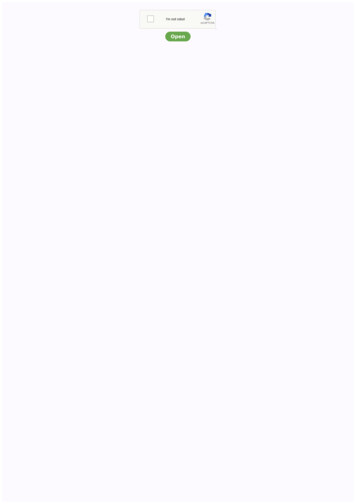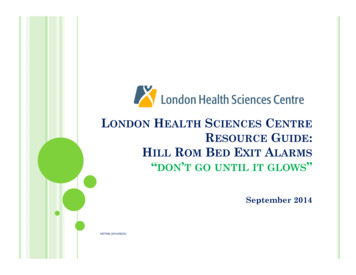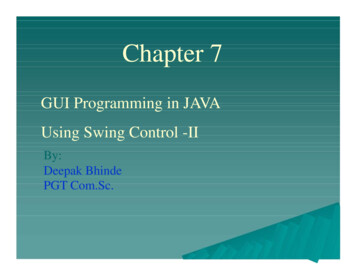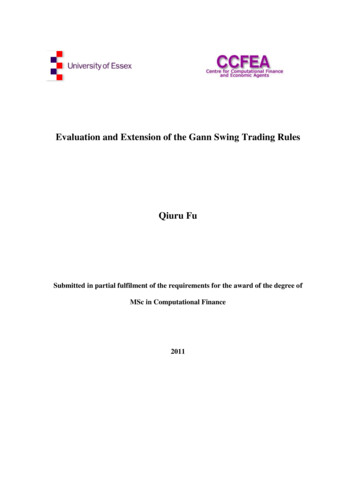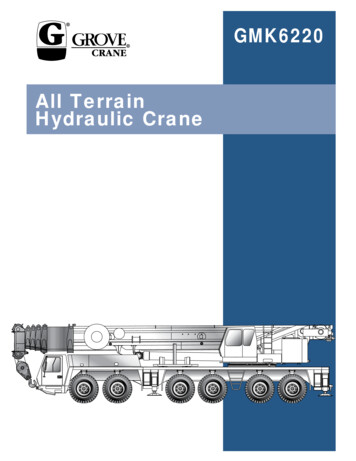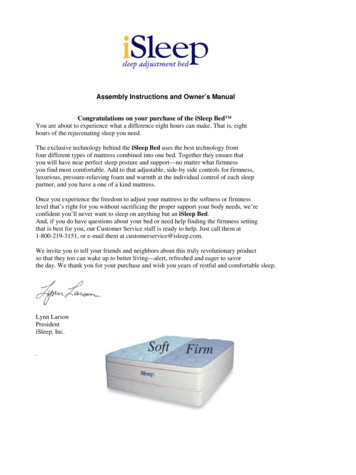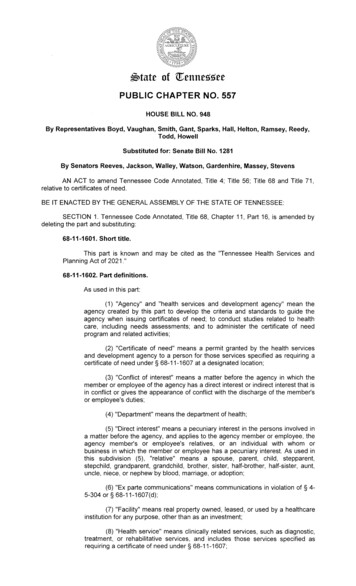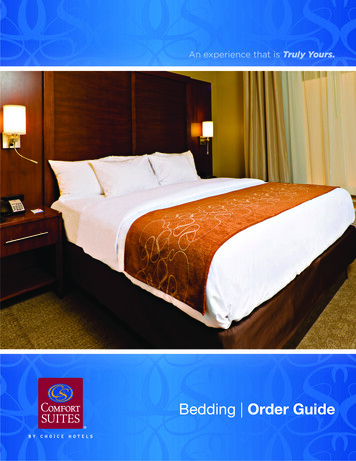
Transcription
5110 Maryland Way, Suite 200, Brentwood,2745 North Dallas Pkwy, Suite 100, 3.comwww.gaffeythealthcare.comYOURSWING BEDQUESTIONSANSWERED!
Nationwide Client BaseCurrently provides hospitalmanagement, consultingservices and technology to: Preferred vendor to: Serving community, district, non-profit and critical access hospitalsExample managed hospital client includes Barrett Hospital and Healthcare in Dillon,MT. Ranked as a Top 100 Critical Access Hospital for 8 years in a rowExample technology and AR servicesclient includes two-hospital NFP systemin southeast GA with numerousassociated physician practicesCalifornia Critical Access HospitalNetworkWestern Healthcare AlliancePartner with Illinois Critical AccessHospital NetworkVizient Group Purchasing Organization
Areas of ExpertiseStrategy – Solutions - SupportGovernance & StrategyFinance Executive management & leadership developmentCommunity health needs assessmentLean culturePerformance optimization & margin improvementRevenue cycle & business office improvementAR outsourcingRecruitmentClinical Care & Operations Executive and interim recruitmentCEOs, CFOs, CNOsVP and Department DirectorsContinuous survey readinessCare coordinationSwing bed consulting
INSTRUCTIONS FOR TODAY’S WEBINAR4You may type a question in the text box if you have a questionduring the presentationWe will try to cover all of your questions – but if we don’t get tothem during the webinar we will follow-up with you by e-mailYou may also send questions after the webinar to our team(contact information is included at the end of the presentation)The webinar will be recorded and the recording will beavailable on the HealthTechS3 web hTechS3 hopes that the information contained herein will be informative and helpful on industry topics. However, please note that thisinformation is not intended to be definitive. HealthTechS3 and its affiliates expressly disclaim any and all liability, whatsoever, for any suchinformation and for any use made thereof. HealthTechS3 does not and shall not have any authority to develop substantive billing or codingpolicies for any hospital, clinic or their respective personnel, and any such final responsibility remains exclusively with the hospital, clinic ortheir respective personnel. HealthTechS3 recommends that hospitals, clinics, their respective personnel, and all other third party recipients ofthis information consult original source materials and qualified healthcare regulatory counsel for specific guidance in healthcarereimbursement and regulatory matters. HTS3 2019
Your Swing Bed Questions AnsweredDate: October 4, 2019 Time: 1:00 pm CSTPresenter : Carolyn St.Charles, RN, BSN, MBA, Regional Chief Clinical OfficerHealthTechS3https://bit.ly/2l3pyAOCMS Changes, CoPs and Discharge Planning Requirements – What do They Mean forYour Organization?Date: October 18, 2019 Time: 12pm CSTPresenter : Carolyn St.Charles, RN, BSN, MBA, Regional Chief Clinical Officerhttps://bit.ly/2pgVALyChronic Care Management Coding: How to Deal with Combo Codes and The Impacton RevenueDate: October 24, 2019 Time: 12:00 pm CSTPresenters : Faith M Jones, MSN, RN, NEA-BC, Director of Care Coordination andLean Consulting, HealthTechS3Julianna Seaman, CCS, CCS-P, Coding and CDI Director, eCatalyst HealthcareSolutionshttps://bit.ly/2lLChZdBest Practices from Nurse LeadersDate: November 1, 2019 Time: 1pm CSTPresenter : Carolyn St.Charles, RN, BSN, MBA, Regional Chief Clinical Officerhttps://bit.ly/2niijG7Diversity and Inclusion at the Hospital Senior Leadership Team LevelDate: November 15, 2019 Time: 1:00 pm CSTPresenter : Peter Goodspeed, MBA, VP of Executive Search, HealthTechS3https://bit.ly/2ngdWvcUnderstanding Lean and Using a Kaizen Event to Improve Multi-DepartmentProcessesDate: November 21, 2019 Time: 12pm CSTPresenters: Faith M Jones, MSN, RN, NEA-BC, Director of Care Coordination and LeanConsulting, HealthTechS3Tracy Clarno, PMP, CPHQ, Think Lean Consultinghttps://bit.ly/2nggbi6Planning for a Successful Hospital SurveyDate: December 6, 2019 Time: 1pm CSTPresenter: Carolyn St.Charles, RN, BSN, MBA, Regional Chief Clinical Officerhttps://bit.ly/2mMPeCb8 Critical Strategies for Interim ExecutivesDate: December 11, 2019 Time: 12pm CSTPresenter: Mike Lieb, Vice President – Interim Services, HealthTechS3https://bit.ly/2nbUgs9Team-Based Care and Achieving Optimal PerformanceDate: December 19, 2019 Time: 12pm CSTPresenters: Faith M Jones, MSN, RN, NEA-BC, Director of Care Coordination and LeanConsulting, HealthTechS3Kara Beech, Beech Creative Grouphttps://bit.ly/2l7ZFzTALL WEBINARS ARE RECORDED
PRESENTER3Carolyn began her healthcare career as a staff nurse inIntensive Care. She has worked in a variety of staff,administrative and consulting roles and has been in hercurrent position as Regional Chief Clinical Officer withHealthTechS3 for the last fifteen years.Carolyn St.CharlesRegional Chief Clinical OfficerIn her role as Regional Chief Clinical Officer, CarolynSt.Charles conducts mock surveys for Critical AccessHospitals, Acute Care Hospitals, Long Term Care, RuralHealth Clinics, Home Health and Hospice. Carolyn alsoprovides assistance in developing strategies forcontinuous survey readiness and developing plans ofcorrection.Carolyn also has extensive experience in working withrural hospitals to both develop and strengthen Swing 584-9868 HTS3 2019
7Regulatory ResourcesAppendix W Guidance/Manuals/Downloads/som107ap w cah.pdfAppendix A ance/Guidance/Manuals/downloads/som107ap a hospitals.pdfAppendix PP (Long Term Guidance/Manuals/downloads/som107ap pp guidelines ltcf.pdfMedicare Benefits Manual Chapter ance/Manuals/Downloads/bp102c08.pdfChanges published September 30, 2019Omnibus Burden Reduction Final Rule CMS – 334Discharge teroperability-and-patient-preferences
8CoPs Swing Bed (October 2018)1.Resident Choice of Physician - Clarification2.Timelines for Reporting Abuse - New3.PASARR – Clarification4.Plan of Care – Additional language and Clarification5.Provide Culturally-Competent and Trauma Informed Care – New6.Reconciliation of Pre-Discharge Medications with Post-Discharge Medications – New7.Dental Care – Clarification of Timelines8.Transfer & Discharge – Information at Discharge and Ombudsman Notification - New
Omnibus Burden Reduction Final Rule CMS – 3346-FHospital and CAH Swing-Bed Providers We are removing the cross reference to § 483.10(f)(9) at § 482.58(b)(1) (for hospital swing-bed providers) and§ 485.645(d)(1) (for CAH swing-bed providers); the repealed provisions gave a resident the right to choose to, or refuseto, perform services for the facility if they so choose. We are removing the cross-reference to § 483.24(c) at § 482.58(b)(4) (for hospital swing-bed providers) and§ 485.645(d)(4) (for CAH swing-bed providers) requiring that the facility provide an ongoing activity program based onthe resident's comprehensive assessment and care plan directed by a type of qualified professional specified in theregulation. because the patient’s activity needs are addressed in the nursing care plan We are removing the cross-reference to § 483.70(p) at § 482.58(b)(5) (for hospital swing-bed providers) and§ 485.645(d)(5) (for CAH swing-bed providers requiring facilities with more than 120 beds to employ a social worker onfull-time basis). We are removing the cross-reference to § 483.55(a)(1) at § 482.58(b)(8) (for hospital swing-bed providers) and§ 485.645(d)(8) (for CAH swing-bed providers) requiring that the facility assist residents in obtaining routine and 24hour emergency dental care. because of the existing requirement for hospitals and CAHs to provide care in accordance with the needs of thepatient (emergent and non-emergent)9
10You asked a lot of questions!Pre-AdmissionAdmissionContinued StayDischarge
11Pre-Admission
12What swing bed policies do we need?Pre-Admission1. Pre-Admission processes including process for acceptingpatients2. Admission criteriaAdmission - Patient1. Admission packet and admission processes including patientdisclosures, orders, medical record, etc.2. Patient Rights, including freedom from restraints3. Privacy and confidentiality, including visitation4. Reporting abuse5. Filing a complaint6. Patient financial obligations7. Patient choice of physician and how to contact provider(s)Admission1. Physician orders2. Medical Record3. Multi-disciplinary assessment including assessment of trauma4. PASARR (Review)Continuing Care1. Multi-disciplinary care conferences including who attends2. Multi-disciplinary plan of care including who develops plan3. Activities4. Nutrition5. Dental care6. Leave of absence (if allowed by facility)Discharge1. Discharge or transfer patient notifications, includingnotification of ombudsman2. Discharge or transfer notifications for next provider of care3. Medication reconciliationDon’t forget the admission packet!
13Can we combine swing bed policies with acute care?Pre-Admission1.Pre-Admission processes including process for accepting patients2.Admission criteriaAdmission - Patient1.Admission packet and admission processes including patient disclosures, orders, medical record, etc.2.Patient Rights, including freedom from restraints3.Privacy and confidentiality, including visitation4.Reporting abuse5.Filing a complaint6.Patient financial obligations7.Patient choice of physician and how to contact provider(s)Admission – Team1.Physician orders2.Medical Record3.Multi-disciplinary assessment including assessment of trauma4.PASARR (Review)Continuing Care1.Multi-disciplinary care conferences including who attends2.Multi-disciplinary plan of care including who develops plan3.Activities4.Nutrition5.Dental care6.Leave of absence (if allowed by facility)Discharge1.Discharge or transfer patient notifications, including notification of ombudsman2.Discharge or transfer notifications for next provider of care3.Medication reconciliationAnswer: MaybeSome Swing Bed regulatory requirements ---- are NOT applicable to acute care Patient Rights Visitation Financial Obligations Choice of physicians Contact information for providers Multi-disciplinary care conferences and development of plan of care Culturally competent trauma-informed care PASARR Discharge
Are critical access hospitals required to have a social service worker onstaff for the swing bed program?Answer: NO – but you must provide medically-related social servicesCAH: C-0386 (Rev. 183, Issued: 10-12-18, Effective: 10-12-18, Implementation: 10-12-18)§485.645(d)(5) Social Services (§483.40(d) and §483.70(p) of this chapter).§483.40(d) The facility must provide medically-related social services to attain or maintain the highest practicable physical, mental andpsychosocial wellbeing of each resident.§483.70(p) Social worker. Any facility with more than 120 beds must employ a qualified social worker on a full-time basis. A qualified socialworker is:(1) An individual with a minimum of a bachelor's degree in social work or a bachelor's degree in a human services field including, but notlimited to, sociology, gerontology, special education, rehabilitation counseling, and psychology; and(2) One year of supervised social work experience in a health care setting working directly with individuals.Hospital: A-1570 (Rev. 183, Issued: 10-12-18, Effective: 10-12-18, Implementation: 10-12-18)§482.58(b)(5) Social services (§483.40(d) and 483.70(p)) §483.40 (d): The facility must provide medically-related social services to attain or maintain the highest practicable physical, mental andpsychosocial wellbeing of each resident. §483.70 (p): Social worker. Any facility with more than 120 beds must employ a qualified social worker on a full-time basis. A qualified socialworker is:(1) An individual with a minimum of a bachelor's degree in social work or a bachelor's degree in a human services field including, but notlimited to, sociology, gerontology, special education, rehabilitation counseling, and psychology; and(2) One year of supervised social work experience in a health care setting working directly with individuals.14
Are there clear requirements for patients to be admitted to swing bed besidesthe three night stay by Medicare?Answer: YES1.The patient has Medicare Part A and has benefit days available2.Medicare age or disability/disease eligibility requirements must be met3.There must be a three‐day qualifying stay (observation doesn’t count)4.Swing Bed admission condition is the same as the qualifying stay condition5.Patient must be admitted to Swing Bed within thirty days of discharge from acute care6.The patient’s condition meets criteria to necessitate inpatient skilled nursing servicesMedicare Benefit Policy Manual – (Rev. 242, 03-16-18)Chapter 8 - Coverage of Extended Care (SNF) Services Under Hospital Insurance15
16Are there any changes in qualifications for swing bed admissions?Answer: NO for Medicare ---- but it depends on the payor30.2.1 - Skills of qualified technical or professional health personnel30.2.1 - Provided directly by or under the general supervision of skilled nursing or skilled rehabilitation personnel30.2.2 - Complexity of services provided30.2.3.1 - Management and Evaluation of a Patient Care Plan30.2.3.2 - Observation and Assessment of Patient’s Condition30.2.3.3 - Teaching and Training ActivitiesMedicare Benefit Policy Manual Chapter 8 - Coverage of Extended Care (SNF) Services Under Hospital Insurance(Rev. 249, 11-02-18)
17Medicare Skilled Criteria30.2.1 - Skilled Services Defined: Skilled nursing and/or skilled rehabilitation services are those services, furnished pursuantto physician orders, that: Require the skills of qualified technical or professional health personnel such as registered nurses, licensed practical(vocational) nurses, physical therapists, occupational therapists, and speech-language pathologists or audiologists; and Must be provided directly by or under the general supervision of these skilled nursing or skilled rehabilitation personnelto assure the safety of the patient and to achieve the medically desired result.NOTE: “General supervision” requires initial direction and periodic inspection of the actual activity. However, the supervisorneed not always be physically present or on the premises when the assistant is performing services.Skilled care may be necessary to improve a patient’s current condition, to maintain the patient’s current condition, or toprevent or slow further deterioration of the patient’s condition.
18Medicare Skilled Criteria30.2.2 - Principles for Determining Whether a Service is SkilledIf the inherent complexity of a service prescribed for a patient is such that it can be performed safely and/or effectivelyonly by or under the general supervision of skilled nursing or skilled rehabilitation personnel, the service is a skilled service;e.g., the administration of intravenous feedings and intramuscular injections; the insertion of suprapubic catheters; andultrasound, shortwave, and microwave therapy treatments.The A/B MAC (A) considers the nature of the service and the skills required for safe and effective delivery of that service indeciding whether a service is a skilled service. While a patient’s particular medical condition is a valid factor in deciding ifskilled services are needed, a patient’s diagnosis or prognosis should never be the sole factor in deciding that a service isnot skilled.
19Medicare Skilled Criteria30.2.2 - Principles for Determining Whether a Service is SkilledEXAMPLE: When rehabilitation services are the primary services, the key issue is whether the skills of a therapist are needed.The deciding factor is not the patient’s potential for recovery, but whether the services needed require the skills of a therapistor whether they can be provided by nonskilled personnel. (See §30.5.)A service that is ordinarily considered nonskilled could be considered a skilled service in cases in which, because of specialmedical complications, skilled nursing or skilled rehabilitation personnel are required to perform or supervise it or to observethe patient. In these cases, the complications and special services involved must be documented by physicians' orders andnotes as well as nursing or therapy notes.
20Medicare Skilled Criteria30.2.2 - Principles for Determining Whether a Service is SkilledEXAMPLE:Whirlpool baths do not ordinarily require the skills of a qualified physical therapist. However, the skills, knowledge, andjudgment of a qualified physical therapist might be required where the patient’s condition is complicated by circulatorydeficiency, areas of desensitization, or open wounds. The documentation needs to support the severity of the circulatorycondition that requires skilled care (see section 30.2.2.1).In determining whether services rendered in a SNF constitute covered care, it is necessary to determine whether individualservices are skilled, and whether, in light of the patient’s total condition, skilled management of the services provided isneeded even though many or all of the specific services were unskilled.
21Medicare Skilled Criteria30.2.2 - Principles for Determining Whether a Service is SkilledEXAMPLE:An 81-year-old woman who is aphasic and confused, suffers from hemiplegia, congestive heart failure, and atrial fibrillation,has suffered a cerebrovascular accident, is incontinent, has a Stage 1 decubitus ulcer, and is unable to communicate and makeher needs known. Even though no specific service provided is skilled, the patient’s condition requires daily skilled nursinginvolvement to manage a plan for the total care needed, to observe the patient’s progress, and to evaluate the need forchanges in the treatment plan.As discussed in section 30.2.2.1 below, the medical condition of the patient must be described and documented to support thegoals for the patient and the need for skilled nursing services.The importance of a particular service to an individual patient, or the frequency with which it must be performed, does not, byitself, make it a skilled service.
22Medicare Skilled Criteria30.2.2 - Principles for Determining Whether a Service is SkilledEXAMPLE:A primary need of a nonambulatory patient may be frequent changes of position in order to avoid development of decubitusulcers. However, since such changing of position does not ordinarily require skilled nursing or skilled rehabilitation personnel,it would not constitute a skilled service, even though such services are obviously necessary.The possibility of adverse effects from the improper performance of an otherwise unskilled service does not make it a skilledservice unless there is documentation to support the need for skilled nursing or skilled rehabilitation personnel. Although theact of turning a patient normally is not a skilled service, for some patients the skills of a nurse may be necessary to assureproper body alignment in order to avoid contractures and deformities. In all such cases, the reasons why skilled nursing orskilled rehabilitation personnel are essential must be documented in the patient’s record.
23Medicare Skilled Criteria30.2.3.1 - Management and Evaluation of a Patient Care PlanEXAMPLE:An aged patient with a history of diabetes mellitus and angina pectoris is recovering from an open reduction of the neck ofthe femur. He requires, among other services, careful skin care, appropriate oral medications, a diabetic diet, a therapeuticexercise program to preserve muscle tone and body condition, and observation to notice signs of deterioration in hiscondition or complications resulting from his restricted (but increasing) mobility. Although any of the required services couldbe performed by a properly instructed person, that person would not have the capability to understand the relationshipamong the services and their effect on each other. Since the nature of the patient’s condition, his age and his immobilitycreate a high potential for serious complications, such an understanding is essential to assure the patient’s recovery andsafety. The management of this plan of care requires skilled nursing personnel until such time as skilled care is no longerrequired in coordinating the patient’s treatment regimen, even though the individual services involved are supportive innature and do not require skilled nursing personnel. The documentation in the medical record as a whole is essential for thisdetermination and must illustrate the complexity of the unskilled services that are a necessary part of the medical treatmentand which require the involvement of skilled nursing personnel to promote the stabilization of the patient's medical conditionand safety.
24Medicare Skilled Criteria30.2.3.1 - Management and Evaluation of a Patient Care PlanEXAMPLE:An aged patient is recovering from pneumonia, is lethargic, is disoriented, has residual chest congestion, is confined to bed asa result of his debilitated condition, and requires restraints at times. To decrease the chest congestion, the physician hasprescribed frequent changes in position, coughing, and deep breathing. While the residual chest congestion alone would notrepresent a high risk factor, the patient’s immobility and confusion represent complicating factors which, when coupled withthe chest congestion, could create high probability of a relapse. In this situation, skilled overseeing of thenonskilled services would be reasonable and necessary, pending the elimination of the chest congestion, to assure thepatient’s medical safety. The documentation in the medical record as a whole is essential for this determination and mustillustrate the complexity of the unskilled services that are a necessary part of the medical treatment and which require theinvolvement of skilled nursing personnel to promote the patient's recovery and medical safety in view of the patient's overallcondition.
25Medicare Skilled Criteria30.2.3.2 - Observation and Assessment of Patient’s ConditionEXAMPLE:A patient with arteriosclerotic heart disease with congestive heart failure requires close observation by skilled nursingpersonnel for signs of decompensation, abnormal fluid balance, or adverse effects resulting from prescribed medication.Skilled observation is needed to determine whether the digitalis dosage should be reviewed or whether other therapeuticmeasures should be considered, until the patient’s treatment regimen is essentially stabilized. The medical documentationmust describe the skilled services that require the involvement of nursing personnel to promote the stabilization of thepatient's medical condition and safety.
26Medicare Skilled Criteria30.2.3.2 - Observation and Assessment of Patient’s ConditionEXAMPLE:A patient has undergone peripheral vascular disease treatment including revascularization procedures (bypass) with open ornecrotic areas of skin on the involved extremity. Skilled observation and monitoring of the vascular supply of the legs isrequired. The medical documentation must describe the skilled services that require the involvement of nursing personnel topromote the patient's recovery and medical safety in view of the patient's overall condition.
27Medicare Skilled Criteria30.2.3.2 - Observation and Assessment of Patient’s ConditionEXAMPLE:A patient has undergone hip surgery and has been transferred to a SNF. Skilled observation and monitoring of the patient forpossible adverse reaction to the operative procedure, development of phlebitis, or skin breakdown, is both reasonable andnecessary. The medical documentation must describe the skilled services that require the involvement of nursing personnelto promote the patient's recovery and medical safety in view of the patient's overall condition.
28Medicare Skilled Criteria30.2.3.2 - Observation and Assessment of Patient’s ConditionEXAMPLE:A patient has been hospitalized following a heart attack, and following treatment but before mobilization, is transferred to theSNF. Because it is unknown whether exertion will exacerbate the heart disease, skilled observation is reasonable andnecessary as mobilization is initiated, until the patient’s treatment regimen is essentially stabilized. The medicaldocumentation must describe the skilled services that require the involvement of nursing personnel to promote thestabilization of the patient's medical condition and safety.
29Medicare Skilled Criteria30.2.3.2 - Observation and Assessment of Patient’s ConditionEXAMPLE:A frail 85-year-old man was hospitalized for pneumonia. The infection was resolved, but the patient, who had previouslymaintained adequate nutrition, will not eat or eats poorly. The patient is transferred to a SNF for monitoring of fluid andnutrient intake, assessment of the need for tube feeding and forced feeding if required. Observation and monitoring byskilled nursing personnel of the patient’s oral intake is required to prevent dehydration. The medical documentation mustdescribe the skilled services that require the involvement of nursing personnel to promote the patient's recovery and medicalsafety in view of the patient's overall condition.
30Medicare Skilled Criteria30.2.3.2 - Observation and Assessment of Patient’s ConditionEXAMPLE:A patient with congestive heart failure may require continuous close observation to detect signs of decompensation,abnormal fluid balance, or adverse effects resulting from prescribed medication(s) that serve as indicators for adjustingtherapeutic measures. The medical documentation must describe the skilled services that require the involvement of nursingpersonnel to promote the patient’s recovery and medical safety in view of the patient’s overall condition, to maintain thepatient’s current condition, or to prevent or slow further deterioration in the patient’s condition.
31Medicare Skilled Criteria30.2.3.3 - Teaching and Training ActivitiesTeaching and training activities, which require skilled nursing or skilled rehabilitation personnel to teach a patient how tomanage their treatment regimen, would constitute skilled services. Some examples are: Teaching self-administration of injectable medications or a complex range of medications; Teaching a newly diagnosed diabetic to administer insulin injections, to prepare and follow a diabetic diet, and to observefoot-care precautions; Teaching self-administration of medical gases to a patient; Gait training and teaching of prosthesis care for a patient who has had a recent leg amputation; Teaching patients how to care for a recent colostomy or ileostomy; Teaching patients how to perform self-catheterization and self-administration of gastrostomy feedings; Teaching patients how to care for and maintain central venous lines, such as Hickman catheters; Teaching patients the use and care of braces, splints and orthotics, and any associated skin care; and Teaching patients the proper care of any specialized dressings or skin treatments.The documentation must thoroughly describe all efforts that have been made to educate the patient/caregiver, and theirresponses to the training. The medical record should also describe the reason for the failure of any educational attempts, ifapplicable.
32Medicare Skilled Criteria30.2.3.3 - Teaching and Training ActivitiesEXAMPLE:A newly diagnosed diabetic patient is seen in order to learn to self-administer insulin injections, to prepare and follow adiabetic diet, and to observe foot-care precautions. Even though the patient voices understanding of the nutritional principlesof his diabetic diet, he expresses dissatisfaction with his food choices and refuses to comply with the education he is receiving.This refusal continues, notwithstanding efforts to counsel the patient on the potentially adverse consequences of the refusaland to suggest alternative dietary choices that could help to avoid or alleviate those consequences. The patient’s response tothe recommended treatment plan as well as to all educational attempts is documented in the medical record.
How do you qualify a patient for swing bed that does not need PT/OT/Speech(skilled nursing only)?Answer: Many of the skilled care examples do not include rehab30.2.1 - Skills of qualified technical or professional health personnel30.2.1 - Provided directly by or under the general supervision of skilled nursing or skilled rehabilitation personnel30.2.2 - Complexity of services provided30.2.3.1 - Management and Evaluation of a Patient Care Plan30.2.3.2 - Observation and Assessment of Patient’s Condition30.2.3.3 - Teaching and Training ActivitiesMedicare Benefit Policy Manual Chapter 8 - Coverage of Extended Care (SNF) Services Under Hospital Insurance (Rev. 249, 11-02-18)33
Can a patient be admitted to swing bed if the problem seems to be more socialthan actually needing therapy?34Answer: Maybe to develop a maintenance program – but not specifically for social needsExample: Patient admitted to hospital after a total knee replacement and met PT goals after day 2 or 3 post-op. Patient ispartially blind and lives at home by himself and also has mobility problems due to arthritis on his hip. If he is not a safedischarge due to those limitations, can the patient be admitted to swing bed for continued therapy.30.4.1 – Skilled Physical Therapy (Rev. 1, 10-01-03) A3-3132.3A, SNF-214.3.AThe services must be provided with the expectation,
TN 615.309.6053 www.healthtechs3.com YOUR SWING BED QUESTIONS ANSWERED! 5110 Maryland Way, Suite 200, Brentwood,2745 North Dallas Pkwy, Suite 100, Dallas,
